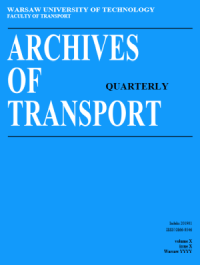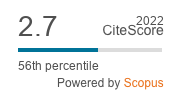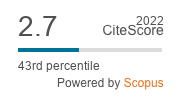Effective time interval for railway track geometry inspection
DOI:
https://doi.org/10.5604/01.3001.0014.1744Keywords:
track geometry, inspection interval, maintenance, degradation, maintenance costAbstract
A proper decision-making scheme for track geometry maintenance requires a knowledge of the real condition of track geometry. Therefore, the track must be inspected by measurement cars at different time intervals. The frequency of track geometry inspection plays a crucial role in decision-making and has always been a big concern for infrastructure managers. The inspection interval should be chosen properly, it means that the small period can decrease the capacity of line and affect the operation of network and the big period can result in low quality of track and in some cases derailments and possible loss of human lives. The aim of this paper is to determine the effective inspection interval such that the total maintenance cost is minimized. In the proposed cost model, the costs of inspection, preventive maintenance, corrective maintenance and the penalty for exceeding the corrective maintenance level are considered. A case study is performed on a real dataset collected from a railway line in Iran. The standard deviation of longitudinal level is considered to measure track geometry degradation. A widely applied linear model is used to model track geometry degradation over time. Monte Carlo technique is used to simulate the track geometry behavior under various track geometry inspection intervals. In addition, a set of sensitivity analyses are carried out to assess the effect of various inspection intervals on different terms of maintenance cost. The results indicate that not only can substantial costs be saved by setting effective inspection intervals, but also the time during which the track suffers from bad conditions is dramatically reduced. The result of this study has shown the appropriate inspection interval for the studied case can result in 13.6 percent decrease in maintenance cost in comparison with the current maintenance policy. Besides, it would lead to more reliable railway track by preventing the system exceed the corrective threshold.
References
Andrade, A.R., & Teixeira, P.F., 2011. Uncertainty in rail-track geometry degradation: Lisbon-Oporto line case study. Journal of Transportation Engineering, 137, 193-200.
Andrade, A.R., & Teixeira, P.F., 2012. A Bayesian model to assess rail track geometry degradation through its lifecycle. Research in Transportation Economics, 36, 1-8.
Andrade, A.R., & Teixeira, P.F., 2013. Hierarchical Bayesian modeling of rail track geometry degradation. Proceedings of the Institution of Mechanical Engineers, Part F: Journal of Rail and Rapid Transit. DOI: 0954409713486619.
Andrews, J., Prescott, D., & De Rozières, F., 2014. A stochastic model for railway track asset management. Reliability Engineering and System Safety. 130, 76-84.
Arasteh Khouy, I., 2013. Cost-effective maintenance of railway track geometry: a shift from safety limits to maintenance limits. PhD Thesis, Luleå University of Technology, Sweden.
Audley, M. & Andrews, J., 2013. The effects of tamping on railway track geometry degradation. Proceedings of the Institution of Mechanical Engineers, Part F: Journal of Rail and Rapid Transit, DOI:0954409713480439.
Caetan, L.F., & Teixeira, P.F., 2016. Predictive Maintenance Model for Ballast Tamping. Journal of Transportation Engineering, DOI: 10.1061/(ASCE)TE.1943-5436.0000825.
Elkhoury, N., Hitihamillage, L., Moridpour, S., & Robert, D., 2018. Degradation Prediction of Rail Tracks: A Review of the Existing Literature. The Open Transportation Journal, 12: 88-104.
EN13848-1, 2008. Railway applications–Track–Track geometry quality–Part 1: Characterisation of track geometry.
EN 13848-5, 2010. Railway applications–Track–Track geometry quality–Part 5: Geometric quality levels – Plain line.
Famurewa, S.M., Juntti, U., Nissen, U., & Ku-mar, U., 2016. Augmented utilisation of possession time: Analysis for track geometry maintenance. Proceedings of the Institution of Mechanical Engineers, Part F: Journal of Rail and Rapid Transit, 230, 1118-1130.
Famurewa, S.M., Xin, T., Rantatalo, M., & Ku-mar, U., 2015. Optimisation of maintenance track possession time: a tamping case study. Proceedings of the Institution of Mechanical Engineers, Part F: Journal of Rail and Rapid Transit, 229, 12–22.
Guler, H., 2014. Prediction of railway track geometry deterioration using artificial neural networks: a case study for Turkish state railways. Structure and Infrastructure Engineering Journal, 10, 614–626.
Gustavsson, E., 2015. Scheduling tamping operations on railway tracks using mixed integer linear programming. EURO Journal on Transportation and Logistics, 4, 97-112.
Helak, M., Smoczyński, P., & Kadziński, A., 2019. Implementation of the common safety method in the European union railway transportation. Scientific Journal of Silesian University of Technology. Series Transport, 102, 65-72.
Janaka, J.K., & Kimitoshi, H., 2016. Deformation characteristics of fresh and fouled ballasts subjected to tamping maintenance. Soils and Foundations Journal, 56, 652-663.
Jovanovic, S., 2004. Railway track quality assessment and related decision making. In: IEEE international conference on systems, man and cybernetics. The Hague, The Netherlands.
Kim, S., & Frangopol, D.M., 2011. Cost-Based Optimum Scheduling of Inspection and Monitoring for Fatigue-Sensitive Structures under Uncertainty. Journal of Structural Engineering, 137, 1319-1331.
Khajehei, H., Ahmadi, A., Soleimanmeigouni, I., & Nissen, A., 2019. Allocation of effective maintenance limit for railway track geometry. Journal of Structure and Infrastructure Engineering, DOI: 10.1080/15732479.2019.1629464.
Konur, D., Farhangi, H., Long, S., & Qin, R., 2014. Track Inspection Planning and Risk Measurement Analysis. Missouri University of Science and Technology.
Lannez, S., Artigues, C., Damay, J., & Gendreau, M., 2015. A railroad maintenance problem solved with a cut and column generation matheuristic. Networks, 66, 40-56.
Li, R., Min, W., & Kim, B.S., 2015. A Predictive maintenance model for railway tracks: integer program to optimize condition-based tamping. International Congress on Advanced Railway Engineering, Istanbul, Turkey.
Lyngby, N., Hokstad, P., & Vatn, J., 2008. RAMS Management of Railway Tracks. The Norwegian University of Science and Technology N-7491 Trondheim, Norway.
Martey, E.N., & Attoh-Okine, N., 2018. Modeling tamping recovery of track geometry using the couplabased approach. Proceedings of the Institution of Mechanical Engineers, Part F: Journal of Rail and Rapid Transit, https://doi.org/10.1177%2F0954409718757556.
Mausevych, O., Kuznetsov, V., & Sychenko, V., 2018. The method for increasing the efficiency of equipments' maintenance in railway traction power supply systems. Archives of Transport, 47(3), 39-47.
Meier-Hirmer, C., Riboulet, G., Sourget, F., & Roussignol, F., 2009. Maintenance optimization for a system with a gamma deterioration process and intervention delay: Application to track maintenance. Proceedings of the Institution of Mechanical Engineers, Part O: Journal of Risk and Reliability, 223, 189-198.
Meier-Hirmer, C., Sourget, F., & Roussignol, M., 2005. Optimising the strategy of track maintenance. In: Kolowrocki K (ed.) Advances in safety and reliability, proceedings of ESREL-European safety and reliability conference 2005, Tri City (Gdynia–Sopot– Gdańsk), Poland.
Miwa, M., 2002. Mathematical programming model analysis for the optimal track maintenance schedule. Quarterly Report of RTRI, 43, 131-136.
Muinde, M.S., 2018. Railway track geometry inspection optimization. master's level, Luleå University of Technology, Sweden.
Osman, M. H., Kaewunruen, S., & Jack, A., 2018. Optimisation of schedules for the inspection of railway tracks. Proceedings of the Institution of Mechanical Engineers, Part F: Journal of Rail and Rapid Transit. 232, 1577-1587.
Oyama, T., & Miwa, M., 2006. Mathematical modeling analyses for obtaining an optimal railway track maintenance schedule. Japan Journal of Industrial and Applied Mathematics, 23, 207–224.
Quiroga, L., & Schnieder, E., 2010. Modelling high speed railroad geometry ageing as a discrete-continuous process. In: Proceedings of the stochastic modeling techniques and data analysis international conference, SMTDA, Chania Crete Greece, pp.655–666.
Quiroga, L.M., & Schnieder, E., 2012. Monte Carlo simulation of railway track geometry deterioration and restoration. Proceedings of the Institution of Mechanical Engineers Part O: Journal of Risk and Reliability, 226, 274-282.
Rudyk, T., Szczepanski, E., and Jacyna, M., 2019. Safety factor in the sustainable fleet management model. Archives of Transport, 49(1), 103-114
Shafahi, Y., & Hakhamaneshi, R., 2009. Application of a maintenance management model for Iranian railways based on the Markov chain and probabilistic dynamic programming. International Journal of Science and Technology, 16, 87–97.
Soleimanmeigouni, I., Ahmadi, A., & Kumar, U., 2018. Track geometry degradation and maintenance modelling: A review. Proceedings of the Institution of Mechanical Engineers, Part F: Journal of Rail and Rapid Transit, 232, 73-102.
Sysyn, M., Gerber, U., Kovalchuk, V., and Nabochenko, O., 2018. The complex phenomenological model for prediction of inhomogeneous deformations of railway ballast layer after tamping works. Archives of Transport, 47(3), 91-107
Vale, C., Ribeiro, I.M., Calcada, R., 2011. Integer programming to optimize tamping in railway tracks as preventive maintenance. Journal of Transportation Engineering, 138, 123-131.
Wolde, M.T., Ghobbar, A.A., 2013. Optimizing inspection intervals-Reliability and availability in terms of a cost model: A case study on railway carriers. Reliability Engineering and System Safety Journal, 114,137-147.
Yousefikia, M., Moridpour, S., Setunge, S., & Mazloumi, E., 2014. Modeling degradation of tracks for maintenance planning on a tram line. Journal of Traffic and Logistics Engineering, 2, 86-91.
Zhang, Y.J., Murray, M.H., & Ferreira, L., 2000. Modelling Rail Track Performance: An Integrated Approach. Proceedings of the Institution of Civil Engineers – Transport, 141, 187-194.
Zhu, M., Cheng, X., Miao, L., Sun, X., & Wang, S., 2015. Advanced stochastic modeling of railway track irregularities. Advances in Mechanical Engineering, 5, https://doi.org/10.1155%2F2013%2F401637
Downloads
Published
Issue
Section
License
Copyright (c) 2024 Archives of Transport journal allows the author(s) to hold the copyright without restrictions.

This work is licensed under a Creative Commons Attribution 4.0 International License.











